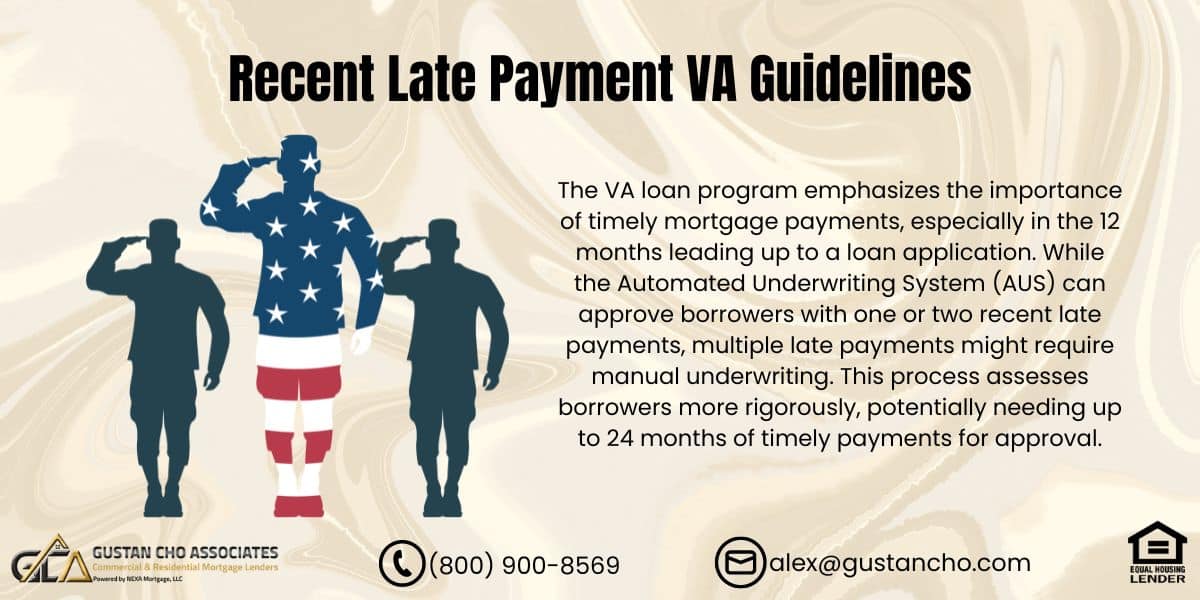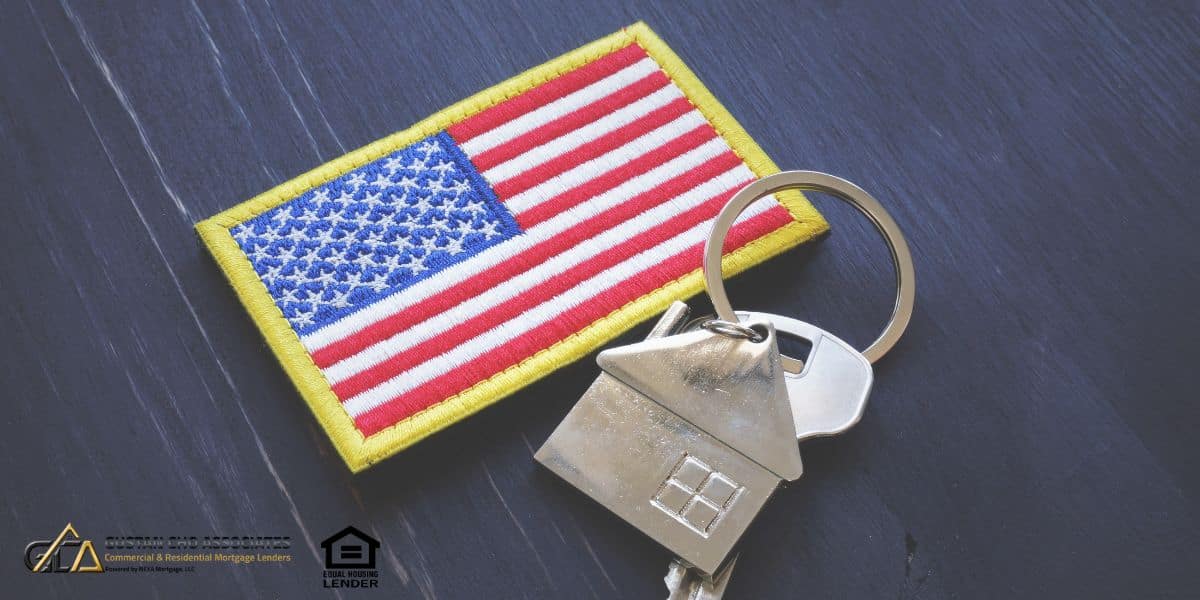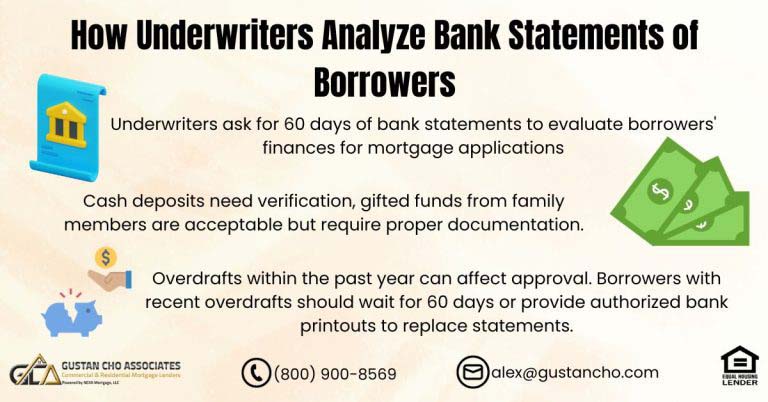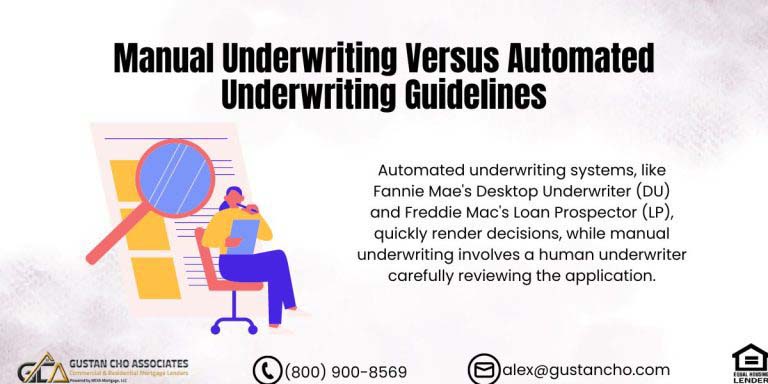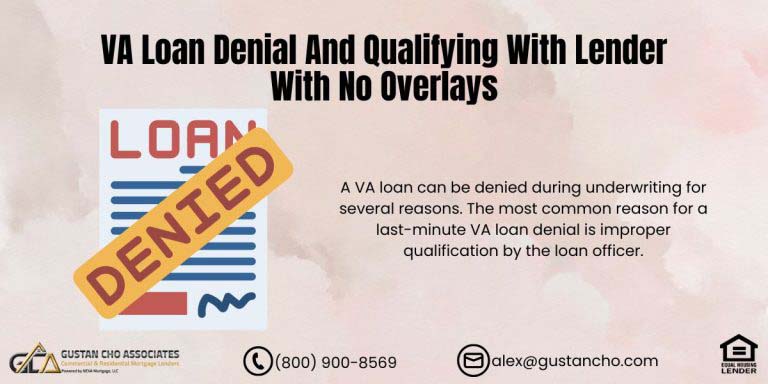VA home loans are ideal for primary residences, offering 100% financing with no down payment required for those who qualify, including active and retired U.S. Armed Forces members and eligible surviving spouses. The key to accessing these benefits is obtaining a Certificate of Eligibility (COE), which confirms eligibility for the VA’s loan program.
The VA is known for its lenient approach towards credit and income evaluations under the Recent Late Payment VA Guidelines, recognizing that military service can lead to financial disruptions that might impact a veteran’s credit history. These guidelines are part of the VA’s efforts to accommodate the unique circumstances of military personnel who may experience frequent relocations or deployments.
This blog aims to shed light on the Recent Late Payment VA Guidelines, particularly focusing on how these rules apply to Automated Underwriting System (AUS) approvals and manual underwriting. It’s important for veterans to understand how these flexible guidelines can help them maintain access to valuable home loan benefits, even if they’ve encountered financial challenges like recent late payments.
What are the Rules for Late Payments on a VA loan?
The VA loan program prioritizes timely mortgage payments, especially in the 12 months following an application for a new loan or refinancing. A consistent record of on-time payments is essential for eligibility. If the applicant’s credit profile is strong but they have one or two recent late payments, the program’s automated underwriting system (AUS) may provide flexibility and potentially approve their application.
Manual underwriting is an option for those who need to meet AUS criteria due to more frequent or severe late payments. This method may necessitate a longer history of punctual payments, up to 24 months, demonstrating a more rigorous evaluation of the applicant’s financial discipline.
Recent updates to the VA loan guidelines have been designed to better support borrowers in managing their payments effectively, especially under difficult economic conditions. These include more forgiving loan modification options that help borrowers maintain stable mortgage situations and avoid future payment issues. These adjustments are part of the broader efforts to accommodate the unique financial challenges veterans and active service members face, as reflected in the Recent Late Payment VA Guidelines.
Facing Recent Late Payments or Bankruptcy? You Can Still Qualify for a VA Loan!
Contact us today to discuss your situation and explore your options
The Automated Underwriting System (AUS) And How It Treats Recent Late Payment VA Guidelines
Under the Recent Late Payment VA Guidelines, having a few late payments within the past 12 months does not necessarily prevent borrowers from receiving approval via the Automated Underwriting System (AUS). Specifically, achieving an AUS approval, designated as “approve/eligible,” is feasible with one or two late payments. However, securing such approval becomes more challenging when multiple late payments are reported within the same timeframe.
The AUS is a complex, highly sophisticated system designed to rapidly evaluate a wide range of borrower data. This data includes credit scores, payment history, income, assets, liabilities, collections, charge-off accounts, late payments, previous bankruptcies, housing events, past employment history, and other relevant information. Based on this comprehensive data review, the AUS will either grant an automated approval, refer the application to manual underwriting, or deny the mortgage.
The outcomes from the AUS are categorized into three types:
- Approve/Eligible: The application meets all VA guidelines, and the AUS has granted approval.
- Refer/Eligible: The AUS cannot automatically approve the application, and it suggests manual underwriting.
- Refer with Caution: The application does not meet VA guidelines, making the borrower ineligible for a VA mortgage under this initial automated assessment.
How The Automated Underwriting System Analyzes Borrowers Credit Profile
When the Automated Underwriting System (AUS) evaluates a VA loan application, it considers the borrower’s overall credit payment history, the presence of seasoned credit tradelines, assets, and lower debt-to-income ratios. Suppose this analysis reveals one or two late payments within the past 12 months. In that case, the system may still issue an approved/eligible decision by Recent Late Payment VA Guidelines.
Suppose the borrower frequently needs to catch up on payment deadlines and has multiple recent late payments within the last year. In that case, the likelihood of receiving AUS approval decreases significantly. A high credit score alone does not guarantee approval, as the AUS assesses comprehensive credit behavior, not just the score.
The system thoroughly reviews the payment history recorded on the borrower’s consumer credit report, making a holistic assessment to determine eligibility.
VA Manual Underwriting Guidelines On VA Home Loans
VA files that receive a “Refer/Eligible” decision from the Automated Underwriting System (AUS) may be subject to manual underwriting. Here are the primary considerations for manual underwriting of VA loans, particularly in cases involving recent late payments:
- Emphasis on Recent Payment History: Timely payments over the last 24 months are important, with special attention given to the most recent 12 months, aligning with the Recent Late Payment VA Guidelines.
- Verification of Rent: Lenders generally require proof of consistent rent payments. However, Gustan Cho Associates offers flexibility for borrowers who live rent-free with family, exempting them from this requirement.
- Low Payment Shock as a Compensating Factor: The manual underwriting process views a low payment shock as a positive factor, indicating minor changes in housing expenses.
Mortgage underwriters have considerable discretion during manual underwriting. Late payments within the past 24 months don’t automatically lead to disqualification. Each application is evaluated individually, ensuring a thorough review tailored to the borrower’s financial situation. This approach reflects a nuanced understanding of the challenges and financial realities that veterans may face, consistent with Recent Late Payment VA Guidelines.
Rebuilding After Bankruptcy? VA Loans Offer a Path to Homeownership
Reach out now to learn how we can assist you in navigating the VA loan process post-bankruptcy.
What is the Minimum Credit Score for a VA Loan?
The VA loan program does not set a minimum credit score requirement. Instead, VA loans are designed to be more flexible and accessible compared to traditional loan types. However, individual lenders offering VA loans may have their own credit score requirements, typically called lender overlays.
Many lenders look for a credit score of at least 620. Still, lenders like Gustan Cho Associates accept lower scores if the borrower demonstrates other strong financial qualifications, such as stable income or low debt-to-income ratios. It’s important to shop around and speak with multiple lenders to find one that accommodates your financial situation.
What is the Maximum DTI for VA Manual Underwriting?
The maximum allowable debt-to-income (DTI) ratio is typically capped at 41% as a standard guideline for VA loans under manual underwriting. However, this limit can be adjusted higher if the borrower demonstrates compensating factors that enhance their creditworthiness.
These compensating factors may include a substantial cash reserve, a consistent and significant income, a high credit score, or demonstrated financial responsibility.
If a borrower has compensating factors, the DTI limits for manual underwriting can be extended:
- With zero compensating factors, the maximum back-end DTI is 43%.
- With one compensating factor, it can increase to 47%.
- It can go up to 50% with two or more compensating factors.
In certain cases, especially where strong compensating factors are presented, lenders may consider DTI ratios as high as 55% for manual underwriting scenarios. This flexibility allows lenders to account for the unique financial situations of veterans or active military personnel who might not meet the standard criteria set by automated systems.
Can Revolving Debt with Less Than 10 Months Remaining be Excluded?
In VA loan underwriting, revolving debts with fewer than 10 months of payments remaining can often be excluded from your debt-to-income (DTI) calculation, which helps determine loan eligibility. However, this is typically at the lender’s discretion and may depend on whether the payments are substantial enough to impact your financial situation significantly. Each lender can have specific policies, known as lender overlays, that might affect this guideline.
For other types of loans, like conventional or FHA, similar rules apply. Debts with fewer than 10 payments left can sometimes be excluded if they do not constitute a significant portion of your monthly obligations. Discussing your specific financial details with a loan officer who can provide guidance based on the most current practices and your financial situation is always a good idea.
For more information on this topic or other mortgage-related questions, feel free to contact us at 800-900-8569 or text us for faster response. Or email us at gcho@gustancho.com. Our team at Gustan Cho Associates Mortgage Group are available 7 days a week, evenings, weekends, and holidays.
FAQ: Recent Late Payment VA Guidelines And Late Payments After Bankruptcy
- What are the eligibility requirements for a VA Loan? To be eligible for a VA loan, the borrower must fulfill specific criteria, including being a current or former member of the U.S. Armed Forces or a surviving spouse of a qualifying veteran. The program offers 100% financing with no down payment required. However, obtaining a Certificate of Eligibility (COE) is necessary to prove eligibility.
- How does the VA view recent late payments when applying for a loan? The VA loan program emphasizes the importance of timely mortgage payments, especially in the 12 months leading up to a loan application. While the Automated Underwriting System (AUS) can approve borrowers with one or two recent late payments, multiple late payments might require manual underwriting. This process assesses borrowers more rigorously, potentially needing up to 24 months of timely payments for approval.
- What is the Automated Underwriting System (AUS), and how does it work with VA Loans? The AUS is a technological tool used to quickly evaluate a borrower’s loan application. It analyzes credit, income, assets, and other relevant information to render a decision. For VA loans, the outcomes include Approve/Eligible, Refer/Eligible, or Refer with Caution. While an Approve/Eligible outcome indicates that all VA guidelines are met, a Refer/Eligible suggests manual underwriting needs.
- What are the manual underwriting guidelines for VA loans? Manual underwriting may be required if the AUS does not approve an application. The key criteria include:
- Timely payments over the past 12 to 24 months.
- Verification of rent if applicable.
- Consideration of low payment shock as a compensating factor.
- Underwriters have discretion in these cases, allowing for individual assessment based on the borrower’s financial situation.
- What is the minimum credit score required for a VA Loan? The VA provides flexibility and accessibility by not setting a minimum credit score for loans. However, lenders may impose their credit score requirements, often called lender overlays. Typically, lenders seek a minimum score of 620, though some may accept lower scores if other financial credentials are strong.
- What is the maximum debt-to-income ratio (DTI) for VA manual underwriting? The standard maximum DTI for VA manual underwriting is generally capped at 41%. However, this can be extended up to 50% or higher with compensating factors such as substantial cash reserves, consistent income, or a high credit score.
- Can revolving debt with less than 10 months remaining be excluded from DTI calculations? Revolving debts with fewer than 10 months remaining may be excluded from DTI calculations under VA loan underwriting, depending on the lender’s policies. This exclusion is typically at the lender’s discretion and depends on the impact of the debt on the borrower’s financial stability.
If you have any questions about the recent late payment VA guidelines or you need to qualify for VA loans with a lender with no overlays, please contact us at 800-900-8569. Text us for a faster response. Or email us at alex@gustancho.com. The team at Gustan Cho Associates is available 7 days a week, on evenings, weekends, and holidays.
This blog about the recent late payment VA guidelines was updated on April 24th, 2024.
Recent Late Payments? We Can Help You Secure a VA Loan
Contact us today to review your credit history and determine your eligibility.


